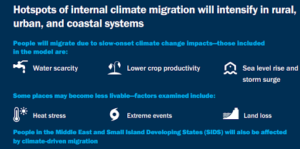In news– Recently, the World Bank released the Groundswell report.
The Groundswell Report Series-
- The first Groundswell report, published in 2018, used a robust and novel modeling approach to help understand the scale, trajectory, and spatial patterns of future climate migration within countries, with a focus on three regions: Sub-Saharan Africa, South Asia, and Latin America.
- Specifically, it examined how slow-onset climate change impacts on water availability and crop productivity, and sea-level rise augmented by storm surge, could affect future internal migration, modeling three plausible scenarios.
- This second Groundswell report builds on that work, applying the same approach to three new regions: the Middle East and North Africa, East Asia and the Pacific, and Eastern Europe and Central Asia.
- Qualitative analyses of climate-related mobility in countries of the Mashreq and in Small Island Developing States (SIDS) are also provided.
- The two reports’ combined findings provide, for the first time, a global picture of the potential scale of internal climate migration across the six World Bank regions, allowing for a better understanding of how projected climate change impacts, population dynamics, and development contexts shape mobility trends.
- They also highlight the far-sighted planning needed to meet this challenge and ensure positive and sustainable development outcomes.
- They take a scenario-based approach and implement a modified form of a gravity model to isolate the projected portion of future changes in spatial population distribution that can be attributed to slow-onset climate factors up to 2050.
Key findings of the report-
- The report finds that climate change, an increasingly potent driver of migration, could force 216 million people across six world regions to move within their countries by 2050.
- It added that hotspots of internal climate migration can emerge as early as 2030 and continue to spread and intensify by 2050.
- It has also found that immediate and concerted action to reduce global emissions and support green, inclusive and resilient development, could reduce the scale of climate migration by as much as 80 per cent.

- As per the report, climate change is a powerful driver of internal migration because of its impacts on people’s livelihoods and loss of livability in highly exposed locations.
- By 2050, sub-Saharan Africa could see as many as 86 million internal climate migrants; east Asia and the Pacific, 49 million; south Asia, 40 million; north Africa, 19 million; Latin America, 17 million and eastern Europe and Central Asia, five million.
















